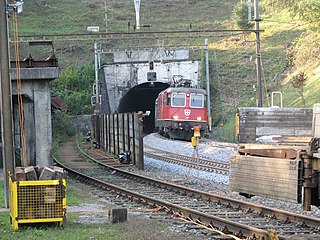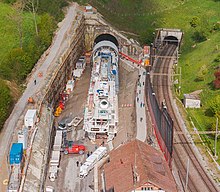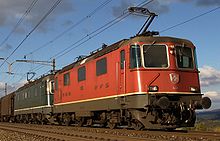Bözberg route
| Basel – Stein-Säckingen – Brugg – Baden | |||||||||||||||||||||||||||||||||||||||||||||||||||||||||||||||||||||||||||||||||||||||||||||||||||||||||||||||||||||||||||||||||||||||||||||||||||||||||||||||||
|---|---|---|---|---|---|---|---|---|---|---|---|---|---|---|---|---|---|---|---|---|---|---|---|---|---|---|---|---|---|---|---|---|---|---|---|---|---|---|---|---|---|---|---|---|---|---|---|---|---|---|---|---|---|---|---|---|---|---|---|---|---|---|---|---|---|---|---|---|---|---|---|---|---|---|---|---|---|---|---|---|---|---|---|---|---|---|---|---|---|---|---|---|---|---|---|---|---|---|---|---|---|---|---|---|---|---|---|---|---|---|---|---|---|---|---|---|---|---|---|---|---|---|---|---|---|---|---|---|---|---|---|---|---|---|---|---|---|---|---|---|---|---|---|---|---|---|---|---|---|---|---|---|---|---|---|---|---|---|---|---|---|
|
South portal of the Bözberg tunnel at the ghost station of Schinznach-Dorf
| |||||||||||||||||||||||||||||||||||||||||||||||||||||||||||||||||||||||||||||||||||||||||||||||||||||||||||||||||||||||||||||||||||||||||||||||||||||||||||||||||
| Timetable field : | 700 | ||||||||||||||||||||||||||||||||||||||||||||||||||||||||||||||||||||||||||||||||||||||||||||||||||||||||||||||||||||||||||||||||||||||||||||||||||||||||||||||||
| Route length: | 65.9 km | ||||||||||||||||||||||||||||||||||||||||||||||||||||||||||||||||||||||||||||||||||||||||||||||||||||||||||||||||||||||||||||||||||||||||||||||||||||||||||||||||
| Gauge : | 1435 mm ( standard gauge ) | ||||||||||||||||||||||||||||||||||||||||||||||||||||||||||||||||||||||||||||||||||||||||||||||||||||||||||||||||||||||||||||||||||||||||||||||||||||||||||||||||
| Power system : | 15 kV 16.7 Hz ~ | ||||||||||||||||||||||||||||||||||||||||||||||||||||||||||||||||||||||||||||||||||||||||||||||||||||||||||||||||||||||||||||||||||||||||||||||||||||||||||||||||
| Maximum slope : | 14.0 ‰ | ||||||||||||||||||||||||||||||||||||||||||||||||||||||||||||||||||||||||||||||||||||||||||||||||||||||||||||||||||||||||||||||||||||||||||||||||||||||||||||||||
|
|||||||||||||||||||||||||||||||||||||||||||||||||||||||||||||||||||||||||||||||||||||||||||||||||||||||||||||||||||||||||||||||||||||||||||||||||||||||||||||||||
The Bözberg line is a standard-gauge railway line in northern Switzerland . It belongs to the Swiss Federal Railways (SBB) and runs from Basel through the Jura to the Aare valley . The route runs via Pratteln , Rheinfelden , Stein-Säckingen and Frick , through the Bözberg tunnel and to Brugg and Baden .
history
When the first railway line between Zurich and Baden was opened by the Swiss Northern Railway on August 9, 1847 , and the Swiss Northeast Railway opened the section from Baden to Brugg on September 29, 1856 , there were already plans for a further connection to the Rhine and to Basel. The project of a railway line from Brugg under the Jura plateau at the Bözbergpass through into the Fricktal also found support from the Aargau cantonal government .
As an alternative to the Hauenstein line of the Swiss Central Railway , which opened in 1858, with the detour via Olten and Aarau , the Swiss Northeast Railway and the Swiss Central Railway jointly formed the Bözberg Railway (BöB), around the direct 49-kilometer route from Pratteln via Rheinfelden and Frick and the Bözberg Tunnel to Brugg to build, which they were able to put into operation on August 2, 1875.
The new line shortened the distance between Basel and Zurich by more than eight kilometers. The trains used the Centralbahn route between Basel and Pratteln, and the Nordostbahn tracks from Brugg to Zurich. The new line was initially built with only one lane, while the engineering structures were already designed for a second lane to be set up later. The maximum gradient of the route is 14 per thousand at the Bözberg ramps. In addition to the 2,526 meter long Bözberg tunnel, the bridge over the Aare above Brugg, which crosses the Aare gorge in a long curve, was the most complex structure on the new railway line. During construction there were difficulties with landslides and the dam above Frick, which was planned with a dam bottom that was too narrow .
In 1895, the section from Pratteln via Rheinfelden to Stein-Säckingen station was expanded to double lanes. It was only after the Bözbergbahn was incorporated into the SBB on January 1, 1902, that the remaining sections of the route received the second track. In November 1904 the section from Stein-Säckingen to Frick was completed, in April 1905 the east ramp to the Bözberg tunnel Brugg to Schinznach-Dorf and in September 1905 the section from the Schinznach-Dorf station through the tunnel to Effingen im Fricktal and up to after Frick. On October 18, 1926, the SBB completed the electrification of the entire route from Pratteln to Brugg.
The Bözberg line still divides the route between Basel and Pratteln with the express train line from Basel to Olten, the Hauenstein line , which provides access to the Gotthard Railway and the Lötschberg line . Relief for the first section south-east of Basel was achieved with the Adlertunnel between Muttenz and Liestal , which opened in 2003 and is now used by the express trains to the Hauenstein tunnel.
New Bözberg tunnel
The Gotthard axis is to be expanded into a 4-meter corridor in order to be able to increasingly shift freight transport across the Alps from road to rail . This is intended to fully exploit the potential of the NEAT . The Bözberg tunnel, however, is structurally unsuitable for this. Different variants were examined in preliminary projects. The construction of a new two-lane tunnel has proven to be the best option. The construction of the 4-meter corridor will cost a total of 940 million francs. As the largest single project, the construction of the Bözberg tunnel costs 350 million francs.
The existing Bözberg tunnel will be used as a service and rescue tunnel in the future. The two tunnels are connected with each other via five cross connections. The northern portal of the new tunnel is near Effingen, the southern one near Schinznach-Dorf. The main driving of the tunnel is carried out with a tunnel boring machine . Construction work began on March 9, 2016. The last sleeper was installed on February 6, 2020. Test operation is planned from May to October 2020, and commissioning is to follow the timetable change on December 13, 2020. The renovation work should be completed by the end of 2022.
Disused train stations
In 1993 the Swiss Federal Railways stopped regional traffic on the railway line between Brugg and Frick. Since then, public transport in this area has been covered by bus route 137 from Postauto Aargau. This means that the train stations in Hornussen , Effingen and Schinznach-Dorf are no longer served by scheduled train services. The former station facility near Hornussen was converted into a simple station area with a siding and two lane changes in terms of operations and security.
At the train station in Effingen, the track construction detachments of the Swiss Army were given the opportunity to carry out operational exercises on a railway system until 2004.
Until December 2008, two Basel S-Bahn trains stopped at the Villnachern stop . A composition that leaves Frick for the night in Brugg late in the evening served Villnachern until 2008. The same composition travels towards Basel in the morning, it also stopped in Villnachern until December 2008 early in the morning. The Villnachern stop has since been closed and the platforms have been demolished.
Importance of the route
The express trains between Basel and Zurich usually run on the Hauenstein route, only the interregios on the Basel – Zurich HB section or between Basel and Zurich Airport run on the Bözberg route. Today this is mainly used for freight transport. The two CityNightLine trains Zurich – Berlin / Prague and Zurich – Amsterdam / Hamburg also ran on the Bözberg line until December 2016.
Freight trains run daily, which also use the Gotthard route. They are mostly hauled in double traction (multiple control) with modern freight locomotives from various railway companies or one SBB Re 4/4 II and one SBB Re 6/6 as so-called Re 10/10 in multiple control .
After the Bözbergrampe, to the west of the Brugg train station, a viaduct connects the tracks to the Südbahn via the line from Brugg to Aarau.
Local goods trains, usually hauled by Re 4/4 locomotives, can also be found between the Muttenz marshalling yard and the lower Fricktal.
Accidents
On January 4 in 1991 for a Radbruch in derailed train station Stein-Säckingen at a passing-by block train 8 of 14 road tankers that transported per 85,000 liters of petrol. A few cars leaked and a major fire broke out that could only be extinguished after 14 hours. Although this accident resulted in no deaths or serious injuries, it is one of the most serious accidents involving dangerous goods on Swiss railways in recent times.
On February 10, 2005, two trains collided at Brugg AG, in which a construction worker died.
Web links
References and comments
- ↑ Bötzbergbahn . In: The Railway . tape 2/3 , no. 8 , 1875, p. 88-89 , doi : 10.5169 / seals-3708 .
- ↑ SBB: The 4-M corridor on the Gotthard axis
- ↑ SBB project page: New Bözberg tunnel for the 4-meter corridor
- ↑ Construction of the new Bözberg tunnel
- ↑ Last sleeper installed in the Bözberg tunnel . In: The Railway Engineer . tape 71 , March 2020, ISSN 0013-2810 , p. 54 .
- ↑ GB: New Bözberg railway tunnel: construction will start in spring 2016 . In: tunnel . Official organ of the STUVA . No. 6/2015 . Bauverlag, October 2015, ISSN 0722-6241 , p. 7 ( online [accessed October 20, 2015]).
- ^ Adrian Hunziker: 20 years ago it burned in stone: "The night was as bright as day". Disasters in Aargau. In: Aargauer Zeitung. July 23, 2012, accessed April 1, 2015 .
- ↑ SBB train kills construction workers. In: look. February 10, 2005, accessed December 7, 2013 .




